As Hungary is shaking itself after another lot of October events (as the 1956 uprising was known euphemistically for many years in the country) and promising to have a budget that will “contain measures required by the European Union”, it might be worth taking another look at the last few weeks for, although this was not another 1956 (and Gyurcsány may be a less than totally honest individual and politician but he is no Mátyás Rákosy) the events have shaken Eastern Europe and the EU more than somewhat.
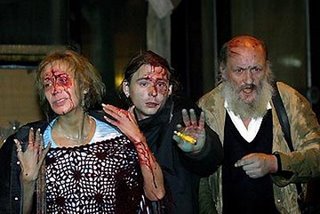 The second demonstration on November 4, anniversary of the Soviet tanks’ return to Budapest did not come to much. It seems that about 1,000 people gathered in Vörösmarty Square, which just happens to have one of the best cafes and patisseries in Budapest, to remember and also to demand various completely unachievable matters, such as the abrogation of the Treaty of Trianon, which in 1920 created a much smaller Hungary than it had ever been before. Two thirds of Hungarian territory and something half of her people found themselves in other countries, two of which, Czechoslovakia and Yugoslavia no longer exist, but the erstwhile Hungarian lands remain in “foreign hands”.
The second demonstration on November 4, anniversary of the Soviet tanks’ return to Budapest did not come to much. It seems that about 1,000 people gathered in Vörösmarty Square, which just happens to have one of the best cafes and patisseries in Budapest, to remember and also to demand various completely unachievable matters, such as the abrogation of the Treaty of Trianon, which in 1920 created a much smaller Hungary than it had ever been before. Two thirds of Hungarian territory and something half of her people found themselves in other countries, two of which, Czechoslovakia and Yugoslavia no longer exist, but the erstwhile Hungarian lands remain in “foreign hands”. On the whole, abrogation of the Treaty of Trianon is not a particularly popular issue. The settling of post-1956 scores, on the other hand, is. One of the post-Communist Socialist-Democrat Prime Ministers, Gyula Horn, had volunteered to serve in the militia that was helping the Soviet troops to mop up the revolutionary groups.
On the whole, abrogation of the Treaty of Trianon is not a particularly popular issue. The settling of post-1956 scores, on the other hand, is. One of the post-Communist Socialist-Democrat Prime Ministers, Gyula Horn, had volunteered to serve in the militia that was helping the Soviet troops to mop up the revolutionary groups.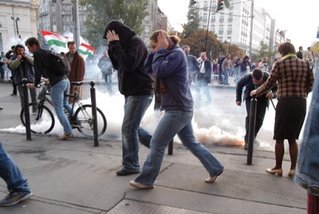 The second Socialist Prime Minister, Péter Medgyessy was proved to have worked for the Secret Police. The present one, Ferenc Gyurcsány was an activity in the Young Communists and managed to pick up some very good bargains during the immediate post-Communist privatization thanks to his excellent connections within the Party. The story of his remarkable outburst on September 18 during which he admitted to lying “morning, noon and night” about the state of the Hungarian economy and the subsequent protests and demonstrations has been told often enough.
The second Socialist Prime Minister, Péter Medgyessy was proved to have worked for the Secret Police. The present one, Ferenc Gyurcsány was an activity in the Young Communists and managed to pick up some very good bargains during the immediate post-Communist privatization thanks to his excellent connections within the Party. The story of his remarkable outburst on September 18 during which he admitted to lying “morning, noon and night” about the state of the Hungarian economy and the subsequent protests and demonstrations has been told often enough.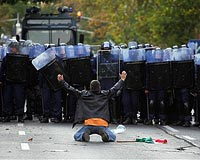 The trouble, of course, is the opposition, FIDESZ, that has not managed to turn itself into a modern, western right-wing party. The leader, Viktor Orbán, about whom many people were hopeful, has not justified those hopes and has, in recent months increasingly linked the party with some of the more extreme nationalist groups. (Though, to be fair, those links remain tenuous.)
The trouble, of course, is the opposition, FIDESZ, that has not managed to turn itself into a modern, western right-wing party. The leader, Viktor Orbán, about whom many people were hopeful, has not justified those hopes and has, in recent months increasingly linked the party with some of the more extreme nationalist groups. (Though, to be fair, those links remain tenuous.)It would seem that FIDESZ found itself at loss when trouble broke out on October 23. They had demanded all kinds of things: a referendum on the reforms, the Prime Minister’s resignation and, indirectly, an admission that the direct heirs of the Communist Party had no right to celebrate the Hungarian Revolution of 1956.
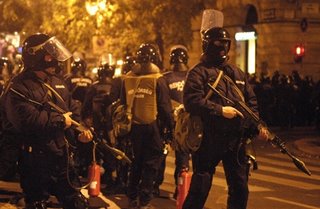 Just before October 23 the police moved in and cleared Kossuth Square of the various people who were staging a permanent demonstration there. This and the continuing police barricades mean that Hungarians themselves cannot approach the main memorial to the uprising and its heroes. Instead, the government with numerous foreign dignitaries turned the whole event into a rather self-serving, pompous occasion.
Just before October 23 the police moved in and cleared Kossuth Square of the various people who were staging a permanent demonstration there. This and the continuing police barricades mean that Hungarians themselves cannot approach the main memorial to the uprising and its heroes. Instead, the government with numerous foreign dignitaries turned the whole event into a rather self-serving, pompous occasion.Tens of thousands demonstrated in Budapest and some other cities and the demonstrations, inevitably, attracted a very large number of people whose own politics is somewhat unsavoury. Protests against “globalization” or reforms can, in the somewhat overheated atmosphere of East European politics and emotionalism, so easily turn into unpleasant forms of nationalism.
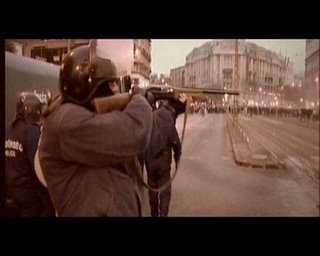 The fact that many groups carried not the national flag of red, white and green, which was good enough in 1848, in 1918, when Hungary became independent again and in 1956 but the mediaeval Árpád flag aroused many people’s worries for two reasons.
The fact that many groups carried not the national flag of red, white and green, which was good enough in 1848, in 1918, when Hungary became independent again and in 1956 but the mediaeval Árpád flag aroused many people’s worries for two reasons.One was the obvious connection with the Hungarian Nazi party of the early forties, the Arrow Cross (Nyilas) Party, which took power in 1944 after Horthy was overthrown and introduced a ferocious Holocaust. Again, one has to be fair: the Arrow Cross had their own symbol added to the flag and that has not made an appearance (in fact, it is illegal in Hungary).
There is, however, another, more convoluted problem. The Árpád flag, a perfectly legitimate mediaeval flag, symbolizes an older, less liberal form of nationalism. It has, more or less, been accepted by FIDESZ and its supporters who speak of the Socialist government as being “illegitimate”. It is, of course, completely legitimate, as is the fact that FIDESZ has in the last local elections taken control of almost all counties and most cities. The question is can modern, democratic politics develop in a country in which the official opposition encourages ideas about dumping the Hungarian constitution and reverting to some form of mediaeval governance, however daft these ideas might seem?
 Finally, there was the role of the police, as seen from pictures dotted in this posting. These were sent to me by an acquaintance who was present at the demonstrations and who feels that the Western media, weeping crocodile tears over the 1956 Revolution and anxious not to show up Ferenc Gyurcsány, has not done them justice.
Finally, there was the role of the police, as seen from pictures dotted in this posting. These were sent to me by an acquaintance who was present at the demonstrations and who feels that the Western media, weeping crocodile tears over the 1956 Revolution and anxious not to show up Ferenc Gyurcsány, has not done them justice.The police, masked and with numbers hidden, attacked the demonstrators with tear gas, iron sticks, which are illegal in Hungarian law and rubber bullets fired at head level. The various photographs demonstrate this and show some of the results of this “routine operation”. Let us not forget that this was going on a few days ago in another EU Member State. The Commission has, somewhat half-heartedly demanded an explanation but no particular sanctions are proposed on the Hungarian government until they sort the mess out (unlike the rather odd sanctions on the Austrian government when the populace had dared to vote for a fairly unpleasant right-wing party, largely to punish the two ineffective main ones).
Well, I feel vindicated. I have always predicted that taking the East European countries and, in particular, Hungary will cause all sorts of problems for the European Union. Of course, once Romania comes in, the problems will increase exponentially. After all, those who want to revise the Treaty of Trianon, undoubtedly have something to say about the Transylvanian question.
COMMENT THREAD
